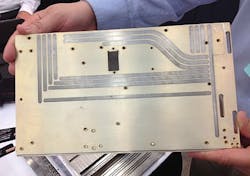ACT designers consider embedded heat pipes to enhance cooling in high-power VPX cards
BALTIMORE, 1 May 2013.Electronics thermal management experts at Advanced Cooling Technologies Inc. (ACT) in Lancaster, Pa., have devised a new cooling technique for high-power VPX embedded computing cards that involves embedded heat pipes to enhance heat removal from computer boards.
ACT officials are cautiously approaching industry with their embedded-heat-pipe technology called Dual-Sided Condenser, which uses heat pipes to move heat from away from the VPX card frame to dissipate via the electronics enclosure.
ACT thermal-management engineers are talking about the Dual-Sided Condenser technology this week at the 2013 SPIE Defense Security + Sensing conference and trade show in Baltimore.
A typical conduction-cooled VPX module moves 70 percent of its heat away from components on the board through the metal card frame, and about 30 percent of its heat through the card wedge lock, which contacts directly with the enclosure wall, explains Bryan Muzyka, sales engineer at ACT.
The company's Dual-Sided Condenser technology, however, offers to balance that heat dissipation to 50 percent from the card frame and 50 percent from the wedge lock, Muzyka says.
Dual-Sided Condenser technology channels heat through heat pipes embedded in the cared frame directly to the wedge lock to enhance how well the wedge lock removes heat, he says.
Although Dual-Sided Condenser technology can make big improvements to electronics heat removal, this approach comes at a price. It can increase the cost of the card frame by about three times, so systems designers must factor the increased cost into their design tradeoff analysis.
For high-performance embedded computing (HPEC) and some high-power RF and microwave applications, however, the increased cost of the Dual-Sided Condenser technology might be worth it.
Systems designers today are struggling to conduction cool embedded systems that call for ever-increasing amounts of power for advanced processors like the Intel Core i7 microprocessor, high-end field-programmable gate arrays (FPGAs), and general-purpose graphics processing units (GPGPUs).
Dual-Sided Condenser technology does not increase the size of the card frame, and adds only miniscule weight to the assembly, Muzyka says. Typically the company will retrofit card frames with the embedded heat pipes to avoid adding bulk, he says.
Typical military embedded computing applications would include radar signal processing, avionics electronics boxes, and RF and microwave systems, he says.
For more information contact Advanced Cooling Technologies online at www.1-act.com.

